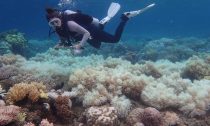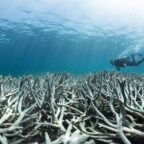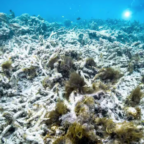
Hard coral cover on the Great Barrier Reef is near record lows in its northern stretch and in decline in the south, surveys by government scientists have found. A report card by the government’s Australian Institute of Marine Science says hard coral cover in the northern region above Cooktown is at 14% – a slight increase on last year but close to the lowest since monitoring began in 1985. A series of “disturbances” – coral bleaching linked to rising water temperatures, crown-of-thorns starfish outbreaks and tropical cyclones – have caused hard coral cover to decline to between 10% and 30% across much of the world heritage landmark over the past five years.
Mike Emslie, the institute’s acting head of long-term monitoring, said the report included glimmers of hope: individual reefs, including those on the outer shelf in the Whitsunday Islands, were found to have lively communities and tiny juvenile corals were discovered across the 2,300km reef system. The density of juvenile coral suggested recovery was possible if there were not further disturbances.
He said it indicated there was some resilience in the system but added: “The important thing is the absence of further disturbances. If we have more coral bleaching events all bets are off.”
The northern and central sections of the reef were hit by back-to-back mass bleaching events as ocean heating increased in early 2016 and 2017, killing vast areas of coral. A study led by Terry Hughes, the director of the ARC Centre of Excellence for Coral Reef Studies, found 30% of coral died after the 2016 heatwave alone.
Intergovernmental Panel on Climate Change scientists estimated 99% of corals across the globe are likely to be lost if the climate crisis is not addressed and global heating reaches 2C.
The Institute of Marine Science report warns the extent of hard coral in the north may be even lower than the 14% estimated due to skewed surveying – the greatest bleaching damage was on inshore reefs and they were under-represented in surveys due to safety concerns. The highest level of coral reef cover recorded in the north was 30% in 1988.
Emslie said the reef’s southern section had escaped the worst effects of coral bleaching and cyclones since 2009 but has been affected by a severe outbreak of crown-of-thorns starfish since 2017. Crown-of-thorns feed on coral and spawns so rapidly it is difficult to tackle once it takes hold. Its spread has been linked to nitrogen from fertiliser and pesticides in agricultural run-off.
He said the starfish had a particularly devastating impact in the Swain Reefs national park, more than 100km off the coast between Rockhampton and Mackay. Across the south, hard coral cover is 24%, down from a high of 43% three decades ago.
The central region, from Airlie Beach to north of Cairns, has been significantly damaged by Tropical Cyclone Debbie in 2017 and the crown-of-thorns’ southward spread. Hard coral cover fell from 14% to 12% last year. It was 22% just three years ago.
The broadcaster and natural historian David Attenborough made headlines this week when he told a UK parliamentary committee that the change to the Great Barrier Reef was one of the clearest examples of the climate crisis he had witnessed. He said it was extraordinary that people in power in Australia remained in denial about the scale of the problem.
Environment group the Australian Marine Conservation Society said the latest government data showed coral decline was happening on an unparalleled scale, mainly due to the climate crisis. The society’s spokeswoman, Shani Tager, said the reef remained a dynamic place that was home to thousands of animals and supported 64,000 tourism jobs but was in serious trouble.
“We need our governments to act fast,” she said.
The science record card coincided with the release of an annual work plan by the Great Barrier Reef Foundation, a formerly small organisation that was last year granted $443m in public funding despite not having applied for it.
The foundation plans to spend $58m this financial year focusing on improving water quality, managing crown-of-thorns starfish and collaborating with the tourism industry to engage visitors in citizen science activities. Anna Marsden, the foundation’s managing director, said innovation would be at the heart of a reef restoration and adaptation program run in collaboration with leading marine science institutions.
Richard Leck, from the World Wide Fund for Nature, said the report card showed Australia needed to urgently reduce its dependence on fossil fuels and accelerate a transition to a clean economy.














Social Profiles